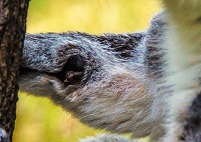Ring-tailed Lemur
Lemur catta
- Habitat: Brush and scrub forests
- Range: South and south-western Madagascar
- Natural Diet: Fruit, flowers, nectar, leaves, and buds
- Status in the Wild: THREATENED
Their ringed tails longer than their bodies
Lemurs are
closely related to other primates such as monkeys and apes and are
only found in Madagascar. Ring-tailed Lemurs are smaller in size
than the ruffed lemurs and are about a foot and a half in length and
weigh between 3 to 5 pounds. Their tails are longer than their
bodies and are around 2 feet in length. Their most prominent feature
is their long white tail with the distinctive black rings which
gives them their name. The underbelly and the inner side of the arms
and legs of Ring-tailed Lemurs are white while the torso and outer
side of their arms and legs are dark grey in color. Their faces are
white with black snouts and black eye patches. Their body colors
help camouflage them from predators. They have slender builds and
long snouts. Males and females are similar in size (monomorphic).
They are active during the day (diurnal) and spend a considerable
proportion of their time on the ground. They are considered to be
the most terrestrial of all species of lemurs.
Diet/ Habitat/
Range
Ring-tailed Lemurs are endemic to Madagascar and live in the southwest region that comprises dry forests, shrublands, cliffs, rocky outcrops, plateaus, and mountains. Information about these lemurs is well documented. They are currently known to live in eight identified populations that occupy eight protected areas include the Amoron’i Onilahy Protected Area, the Andringitra National Park, the Anja Community Reserve, the Berenty Private Reserve, the Beza Mahafaly Special Reserve, the Isalo National Park, the Ihorombe Region of the Ihosy District, and the Tsimanampesotse National Park.
Ring-tailed Lemurs feed on fruits, flowers, seeds, and even sap and bark. When food is scarce, they also feed on insects and invertebrates. One of their popular seasonal food sources is tamarind. Since flowers are a popular seasonal food resource for Ring-tailed Lemurs, they carry the pollen that rubs off onto their fur from flower to flower and are categorized as pollinators.
Behavior
Ring-tailed Lemurs are highly social creatures and live in large family groups that include 30 or more individuals consisting of several males and females. Lemurs are matriarchal with females occupying positions of dominance and power. Thus all Ring-tailed Lemur social groups are led by one dominant female. In large family groups, each lemur occupies a position of power in a hierarchical system. These positions are maintained through grooming privileges where subordinate lemurs groom dominant individuals. Dominant lemurs experience several other privileges such as primary access to food resources, primary rights to breed, and access to partners.
Like the
ruffed lemurs, Ring-tailed Lemurs communicate loudly emitting
several different types of calls for specific purposes. Their
loudest calls are made to let neighboring lemur groups know that the
territory is occupied. They also emit vocalizations to warn members
of their group to watch out for predators that may be close by.
These vocalizations are called alarm calls. Ring-tailed Lemurs
maintain territories to protect their food resources and resting
grounds by scent-marking their territorial boundaries with urine.
Ring-tailed lemurs have been observed to move quadrupedally and
bipedally. They particularly enjoy sitting and basking in the sun
almost in a meditative position.
Reproduction
In their
social groups, Ring-tailed Lemurs males partner with multiple
females with males competing for females during the breeding
seasons. Ring-tailed lemurs are popularly known for their stink
fights where they rub their scent glands located at the base of
their hands on their tails before waving them toward competing
males. Breeding season occurs during the summer months and young are
born in the fall. Females sexually mature by 3 years of age while
males mature by 2.5 years. The gestation
period lasts about 5 months and the litter usually consists of one
or two young. The young wean around 5 months of age. The mother
carries her infants on her abdomen until they are strong enough to
hold on. As they get older, she carries them on her back. Since a
considerable proportion of behavior in their behavioral repertoire
is gained through learning, parents train their young to find food
resources and the right food items to eat, maintain territories to
protect feeding and resting areas, stay alert for predators, and
take care of their young.
Conservation/Status
The most
significant threat to Ring-tailed Lemurs’ population numbers is
habitat loss due to shifting agricultural cultivation. Illegal
hunting and trapping that is currently prevalent have also had a
detrimental effect on their numbers in the wild. Since these threats
lead to a steady population decline, the Union for the Conservation
of Nature has categorized them as
ENDANGERED.



.jpg)

